R. CRUMB AND THE BIRTH OF UNDERGROUND COMIX
A 50th Anniversary Celebration: Part Two
(A History of Sorts but Not At All Encyclopedic or Even Complete; Just EnjoyC Join the Festivities, In Progress)
R. CRUMB=S ZAP COMIX, LAUNCHED in February 1968, marks the official beginning of underground comix. Other prototypical events were afoot before then (and we=ll take a look at some of them herein), but Zap Comix was, at least, a conspicuous landmark, a beacon on the hillCor, more aptly, an exuberant explosion. That was 50 years ago this year, anniversary enough to celebrate, and that=s what we=re doing here. Or, rather, we=re continuing to celebrate here in Harv=s Hindsight, where, last time, we started the party.
Before hoisting our tankards in jubilant jubilation to toast the occasion, we pause to acknowledge other matters, some integral, others tangential.
America culture as a whole was experiencing events as upending and disruptive as anything in revolutionary comic book format, whether ending with an x or not.
The on-going Vietnam War inspired protests that spread beyond the campuses where they started into politics and the wider society. As Jackson Lears outlined in The New York Review of Books (September 27)C1968 was the year of Athe tormented Lyndon Johnson, enmeshed in an unpopular, unwinnable war and choosing to withdraw from the presidential stage; the anti-war candidacies of Eugene McCarthy and Robert Kennedy; the intensifying moral challenges posed by Martin Luther King; the assassinations of King and Kennedy; the racially charged violence in most major cities; the police riot against antiwar protesters (and anyone else who got in their way) at the Democratic National Convention in Chicago; the emergence of right-wing candidatesC George Wallace, Richard NixonCappealing to a >silent majority= whose silence was somehow construed as civic virtue. ...@
The radical protests featured unknown entities who soon became famousCTom Hayden, Mark Rudd, Abbie Hoffman, the Students for a Democratic Society (SDS), the Black Panthers, the Maoists, the Yippies, the devotees of Che.
In the midst of this surging social disruption, underground comix were right at home, a logical outgrowthChowever illogical (even demented) and anti-social their content seemed. And they were cropping up everywhere in and around 1968.
The late undergrounder Jay Lynch believed that the term Aunderground@ came via Time magazine from Andy Warhol, known for his Aunderground@ movies; Time applied the term to underground newspapers and, hence, to the irreverent comic books that grew out of the papers.
Comix most profoundly did something mainstream comic books carefully did not do: comix offered cartoonists the chance for self-expression. They drew for themselves not for the company dollar.
In Underground Classics: The Transformation of Comics Into Comix, Patrick Rosenkranz explains that Acatharsis was often a motivation for comix. Flaunting fears, shedding demons, confession, confrontation and revenge were often behind the creativity. Spain Rodriguez said that underground comix allowed him to exact his revenge on the Comic Code Authority which killed of his favorite EC Comics in 1954.@
Comix suited the period of their birth and blooming: in an age of anti-war protestation and drug use, comix were vehicles of indulgence and protest, chiefly against the mores of conventional American middle class life.
In the book=s longest essay, AThe Undergrounds,@ Paul Buhle peels the onion, a layer at a time, to show interrelationships and, also, completely independent sproutings, thereby coming close to tracing the transformation of comics to comix.
Skimming the surface of his essay to scoop up the nutshells, we learn that the origin of comix can be discerned in college humor magazines, which allegedly inspired Harvey Kurtzman in founding Mad, and Mad, in turn, manifesting the superior artwork of EC Comics as well as a manic satirical humor, fueled many ug cartoonists.
College humor magazines, which were produced without any restraints until they offended ruling faculties, set the pace.
The earliest manifestation of the impudent sensibility of comix found its off-campus outlet in underground tabloid newspapers, most of which had a comics section. The tabloid counterculture
was nurtured in the East Village, San Francisco, and Austin, Texas, not along Madison Avenue in New York, where, until comix, most publishing was done. Papers like the East Village Other, Los Angeles Free Press, Gothic Blimp Works, Yarrowstalks, and a few fugitive others fostered the form and the attitude.
And from these, comix emerged in Aa frantic combination of talent, energy, dope and almost hand-to-hand distribution.
AThe marvel of it all,@ Buhle goes on, Ais that suddenly, almost anything seemed possible. From the beginning, a requisite dose of sex would be sure to add to sales. Most artists, male and female alike, had long wanted to work with a sexual content hitherto forbidden. ...
AUnderground comix deftly united the most vernacular of all arts, the comic book, with political rebellion and a reflective critique of American culture.@
The counterculture=s preoccupation with the Vietnam War, the draft, racism, environmental devastation, corporate greed and the heartless capitalistic Aanything for a profit@ systemCall influenced a spirit of rebellion that engulfed comix, which brimmed with anti-establishment protest in support of the Chicago Eight and Aother prisoners of the mainstream culure.@
Enabled by the advance of printing technology that gave small publishersCand individual cartoonistsCthe means to publish short-run comic books and still turn a small profit, comix had their heyday from 1968 until the mid-1970s. Protypes started earlier in the 1960s, and vestiges lasted long after the 1970s, the most notable being the so-called Aalternative@ press, which carried the publishing legacy of comix forward.
But at the beginning , as we saw in the previous Hindsight, was Crumb.
My editor at The Comics Journal online says that #MeToo has made Crumb persona nongrata . The Journal dare not print any of this essay (the one right here, before your rolling eyeballs) on the 50th anniversary of ugs because Crumb was so prominent in the formative years and because of his sexist (even abusive) attitude toward women, anti-Crumb feeling is running high. At the Ignatz Awards at SPX over the weekend of September 15-16, Athe crowd actually booed his nameCnot once, but twice"@ Once, I suppose, we could overlook. But twice? Can=t overlook that.
Well, phooey. Here at Rancid Raves, we=re always looking for crowd-pleasing things to do, so we=ll run the second half of my underground 50th anniversary piece forthwith, Crumb and all.
THE FIRST TWO ISSUES of Zap that Crumb drew are distinguished by their good-humored playfulness rather than
by any adventurousness in content. Crumb accurately catalogues his work
of 1967-68 as a "sweet, optimistic,
LSD-inspired mystic vision drawn in the loveable big-foot style that everyone
found so appealing." His old fashioned looking
drawings enliven every page with their purely visual comedy: the goofy
galoot-style characters look funny. And they also do funny things, often
in baffling ways (which nonetheless seem funny because of the farcical
appearance of the characters). 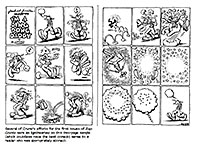
The joyful exuberance of this sort of nonsense is repeated in the first issue of Snatch Comics, too, but these comix, with their raw and unbridled portrayal of sexual athletics, begin to plumb a personal well of sexual hang-ups that Crumb will continue to explore the rest of his career.
Starting with Zap No.2 (June 1968), in the stories about an African amazon named Angelfood McSpade, Crumb gives us an unthinking, absolutely uninhibited child of nature, a wholly sexual creature for whom life and sex are one.
And in Home Grown Funnies No.1 (1971), Whiteman, Crumb's embodiment of repressed American middle class sexuality, is captured by wild female yeti, who makes him her sex slave. He is rescued when she is taken captive, but back in civilization, he finds he isn't happy without her. Arranging for her discharge from the institution in which she's being housed and studied, he tries to make a place for her in his urban household but perceives it's hopeless; in the last panel of the story, he's back in the woods with her. And he's happy.
Again and again in his work of the next several years, Crumb depicts characters with the most insatiable of sexual appetites, endlessly rutting, sweating, gasping, spurting, oozing, and crying out in ecstasy, often in outrageously acrobatic postures. Crumb knew he was breaking taboos:
"I still have doubts sometimes while I'm [working]. It's my linear mind telling me that. There's always a battle with it; you might call it ego. That civilized part of you that always wants to be rational and logical. And the real self that wants to be magical. ... We allC everybodyC [have] this weird shit going on in our heads. I used to censor myself when I drew cartoons. I just stopped censoring, that's all."22 (Yes, footnotes. They=re at the end for anyone who wishes to trace the sources of quotations herein. Otherwise, barge ahead.)
On virtually every page of his comix, Crumb proclaims his own ideal of femininity: a "robust" woman with "big legs" and booty. For all his championing of sex, however, Crumb still seemed to harbor a deep distrust for the opposite sex, a resentment stemming, no doubt, from his lack of success with girls as a teenager.
In two stories about Eggs
Ackley and the Vulture Demonesses (Big Ass Nos.1 and 2, May 1969 and
August 1971), Crumb subjects the female characters (who are attired in leather
and metal) to the most outlandish (and hilarious) physical abuse in the
contortions Eggs forces them into. Despite the degrading treatment, the
demonesses continue to display a sexual appetite as voracious as anything in
male fantasy. 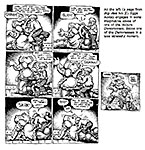
Almost as soon as the first issue of Snatch appeared, Crumb was in trouble with his female readers, most of whom supported the feminist cause. In "Lenore Goldberg and her Girl Commandos" (Motor City No.1, April 1969), Crumb offered up a heroine for the women: Lenore is a militant, jack-booted feminist, who triumphs over male opposition by sheer brute force. But at home, Crumb shows us, she appreciates the sexual attentions of her lover. He repeated the same theme a year later in Motor City No.2.
Over and over again as he labored through the years to purge himself of his "sex rage," Crumb displays his contempt for womenC who had the bad taste to reject him as a teenager and the equally poor judgement later to flock to him simply because he became famous. At times, he could show sympathy for women's time-worn sexual frustration: in "Don't Touch Me," a two-page story depicting an apparent rape for a page-and-a-half, he concludes with the woman in the last panel screaming, "I never get to come__ (Snatch No.3, August 1969).
Crumb was also concerned with larger issues of the human condition. In Despair (1970), for instance, he delivers a sermon on social responsibility by conjuring up a grim view of society overwhelmed by its excesses and negligence. He returned to the theme repeatedly. He consistently attacks the "MacDonald's-shopping mall" materialism of modern America, abuse of power, selfishness, greed, and hypocrisy. And in every story dealing with social issues, he unfailingly invokes the better instincts of human nature (often sexual instincts) as a way out.
He advocates authenticity as a standard for behavior and self-fulfillment as a goal.
Crumb subscribed to no particular panacea for the social ills he saw all around him. In fact, he was largely detached from the energizing political passions of the countercultureC just as the perpetually observant humorist and satirist should be. As R. Fiore says, "he was in the sixties but not of them.... Much as he might have sympathized with the simplistic radical politics of the time, he was always a bit too smart for them. The True Believer is just not in him. No matter how much he tried to submerge his doubts, his attempts to conform to other people's programs lacked conviction. The peace-love-and-mysticism business had very little attraction for him. Crumb envisioned the upheavals of the sixties not so much as the birth of a new consciousness as a bridge to an older one, a return to something like the rural radicalism of the nineteenth century."23
Not even the drug culture escaped Crumb's diabolical scrutiny. Although he was an enthusiastic cheerleader for turning on, he could also see cracks in the euphoric facade. In "Ducks Yas Yas" (Zap No.0), he dwells for all three pages upon the nearly purposeless wanderings of an anonymous doper who is clearly not having a very good time. (Not that he's having a bad time; he's just not having a good time.) The episode is oddly cheerless and bleak despite the character's advocacy of grass and acid.
As a storyteller, Crumb had difficulty with endings in his early work. His tales seldom end with the kind of epiphany of meaning that give short stories their characteristic impact. The resolution of the story about Whiteman and the female yeti is almost a let-down. No balloon bursts. It's very nearly a predictable commonplace, entirely expected from a "back to nature" advocate.
And in stories like "Stinko's New Car" (Your Hytone Comics, 1971), the conclusion is thoroughly ordinary. Crumb shows us Stinko the Clown indulging the aggressive behavior that having a powerful new car fosters in the male animal: he speeds, runs down pedestrians, and bumps into other vehicles, displaying the most anti-social conduct. At the end of the story, he crashes in his car and winds up swathed in bandages and casts in a hospital bed, saying, "SighC you can't win." He gets his just desserts, and we might well expect just that outcome.
Crumb's stories, however, are nonetheless effective satire: his message is delivered throughout the body of the narrative in a perfectly unabashed, undisguised manner. He makes his statement by outrageous assault on orthodox sensibilities. Whiteman is revealed as a wholly repressed male who discovers happiness only by discarding his inhibitions; Stinko shows us just how nasty a person can become if he gives in to the power fantasies that driving a new car inspires. Shock is the essence of Crumb satire. His work explodes the underpinnings of the conventional facades behind which we hide thereby revealing what we really are. And depending upon the subject at hand, what we really are might be betterC or worseC than what we believe about ourselves.
CRUMB'S NONCHALANCE about social taboos did not escape notice by the up-tight establishment he was ridiculing. Here and there, bookstore and headshop operators were arrested for selling Zap and Snatch on the grounds that the books were obscene. In almost every instance, these obscenity busts came to nothing. In one case involving Zap No.2, for exampleC in which one of S. Clay Wilson's scarred pirates slices off another's huge penisC the judge ruled that the episode was not obscene because it did not arouse prurient interest. But such decisions did not resolve the issue, and Crumb continued to expand the arena of satirical expression.
Then in August 1969, copies of Zap No.4 were seized almost as soon as they appeared for sale. The chief offenseC incest depicted in a Crumb story called "Joe Blow." In concocting the tale, Crumb took great pains to establish the Blow family as a model of bland middle-class virtue. Their recreation seems confined to harmless pursuitsC chiefly television viewing (the father) and cooking (the mother). And in rendering their faces, Crumb gave them indistinct generic features and vacuous expressions that radiate a kind of insipid wholesomeness. And then he showed the parents engaging in sex acts with their children.
Crumb's satiric objective, however, is not just to point out the discrepancy between appearances and reality. He has a more illusive goal in view.
After their sexual
exercise, the family members all glow with self-righteousness, saying what a
great time they've had and how much they've learned and recommending that "people should get together with their
kids more often." The story concludes
with the son and daughter going off hand-in-hand while their father says, "There they goC off to make even more new discoveries
and to build a better world." And Mother says, "Yes, youth holds the promise of the
future." 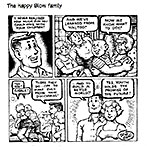
The object of Crumb's ridicule is the rosy middle-America notion that families should do things together because they'll all be better for it. For Crumb, that's too easy a cure for the ills of contemporary America: what, exactly, these families do together is clearly more important than simply "doing things" together. (Moreover, as the metaphor of incest suggests, perhaps family members would become better people if they made connections with people outside their families, different people whose differences might enrich their lives by, say, widening the gene pool. But that might be pushing the metaphor a little too much.)
On the West Coast, charges against Zap Comix No.4 were soon dropped, but in New York, the case reached the docket, and Zap No.4 was declared obscene in March 1973. But there were no obscenity cases involving comix for several years thereafter, which "led many cartoonists to declare that the Zap trial was not an obscenity trial at all but a political bust of the counterculture, deliberately planned to come at a time when the underground comics were beginning to reach a wider audience."24 If comix hadn't been underground before, they were nowC in New York at least.
Meanwhile, back on the West Coast, Dan O'Neill had kicked a sleeping giant and provoked a new threat to comix. O'Neill had been producing a vaguely philosophical strip called Odd Bodkins for the San Francisco Chronicle since about 1967.
Parodic versions of Disney characters frequently wandered through the panels, but the Disney lawyers took no action until 1971 when O'Neill and some friends published the first number of Mickey Mouse Meets the Air Pirates, a comic book that called unwanted attention to some ordinary facts of life. Disney's signal achievement was the creation of a fantasy world so sanitized as to be perfectly harmless entertainment. But what was harmless in entertainment could be dangerous self-delusion in real lifeC at least, so O'Neill believed. And so he set out to correct some erroneous impressions he felt Disney had foisted off on innocent Americans. Most significantly, O'Neill reminded his readers that all animals (including, we assume, humans) have sex lives: he showed Mickey and Minnie Mouse copulating.
Uncle Walt's minions were furious and sued to block publication and distribution of the offending comix, which, they asserted, tarnished the Disney Image. (Bob Levin=s The Pirates and the Mouse: Disney=s War Against the Underground is an excellent book-length examination of this episode.) The Air Pirates were shut down forever. And a frost settled on the underground. Then in June 1973, the U.S. Supreme Court sent an equally chilling message across the entire land with its landmark obscenity decision by which community standards could determine what was obscene. Comix could well have dried up and blown away like autumn leaves. But by then, comix were healthy enough to survive the season of discontent. Their direction had been set. And it had been set by Robert Crumb more than by any other single practitioner of the underground art.
Comics historian Clay Geerdes argues that Crumb's importance at this juncture in the history of comics does not derive from the comix he drew: it originates, rather, in his publishing underground comics in magazine (comic book) form. "It was the book that turned on all those light bulbs and taught people they did not have to submit to the East Coast comic book monopoly and wait for acceptance or rejection. Zap taught them they could do their own."25
The first issues of Zap were undeniably a persuasive demonstration that artistic freedom could be achieved through entrepreneurial enterprise. But Crumb's obvious zest in playing with the medium and his ebullient selection of unconventional subjects to rejoice with were, in my view, just as precedential as the happenstance of his being published in comic book format.
But others were also shaping comix.
IN THE MID-SIXTIES in New York=s Greenwich Village, Spain Rodriguez and Kim Deitch and Art Spiegelman were coalescing, mostly around the East Village Other.
According to St. Wikipedia, the East Village Other was co-founded October 1965 by Walter Bowart, Ishmael Reed (who named the newspaper), Allen Katzman, Dan Rattiner, Sherry Needham and John Wilcock. It began as a monthly and then went biweekly. The EVO, as it was dubbed, was among the first countercultural newspapers to emerge, following the Los Angeles Free Press, which had begun publishing a few months earlier.
The EVO was described by the New York Times as "a New York newspaper so countercultural that it made the Village Voice look like a church circular." The Voice, which had been founded ten years earlier by Dan Wolf, Ed Fancher, John Wilcock and Norman Mailer, is usually recognized as the country=s first alternative newsweekly. Although it hosted a variety of writers and artists and cartoonists (most notably in the latter category, Jules Feiffer), the Voice was not known as a newspaper for cartoonists. The EVO, on the other hand, was.
It was a breeding ground for the underground comix, providing an outlet for artists including Spiegelman, Deitch, Rodriguez, Trina Robbins, and Gilbert Shelton before underground comic books emerged with the publication of the first issue of Zap Comix.
The popularity of comic strips led to the publication of separate comics tabloids, beginning with Zodiac Mindwarp by Rodriguez and continuing with the Gothic Blimp Works.
Comix historian Rosenkranz recalled his reaction to EVO (quoted in Wikipedia):
AI'd never seen a publication like this before. It was full of wild accusations and bawdy language and doctored photographs. It had President Johnson=s head in a toilet bowl. It had naked Slum Goddesses, truly bizarre personal ads, and a whole different slant on the anti-war movement than my hometown paper upstate. But best of all, it had the most outrageous comic strips.
AThe continuing saga of Captain High; the psychedelic adventures of Sunshine Girl and Zoroaster the Mad Mouse; Trashman offing the pigs and scoring babes left and right. While I enjoyed many aspects of EVO, I liked the comics the most.
ABill Beckman was one of the first cartoonists with his counterculture crusader Captain High, whose main mission was to get high and stay high. Beckman didn't draw very well, but EVO's readership could relate to the premise. Beckman contacted his buddy Gilbert Shelton from back at the University of Texas at Austin, who mailed in an occasional strip called Clang Honk Tweet"; Hurricane Nancy Kalish contributed a spacey, Aubrey Beardsley-style comic called Gentle's Tripout. Others came and went without much notice until Bowart commissioned Rodriguez to draw a 24-page all-comic tabloid, which he published as Zodiac Mindwarp in 1966.@
In 1968, Rodriguez had covered the Democratic National Convention in Chicago as a cartoonist reporter for EVO. Deitch had been contributing to the EVO since 1967. He was involved romantically with Robbins, who, in 1966, had arrived in the East Village and set up her dress-making boutique (she made only dresses of her size). She made a deal with EVO: she=d sew for them in return for free advertising, and she produced a comic strip, Broccolistrip, as the ad for her shop, Broccoli.
But the cartoonist whose Village associations stretched back the furthest was Spiegelman, who had been peddling self-published underground comix on street corners since 1966.
Spiegelman started
drawing comics in 1960 when he was 12, saith St. Wikipedia. In 1961 while in
junior high school, Spiegelman produced a Mad-inspired fanzine, Blase. He attended High School of Art and Design in Manhattan and met Woody Gelman who
encouraged him to apply for a job at his Tops Chewing Gum Company after
finishing high school, but after graduating in 1965, Spiegelman enrolled at
Binghamton University=s Harpur College to study
art and philosophy. But he also did freelance work for Topps, for which he=d work steadily for the
next two decades. At Harpur, Spiegelman started a campus humor magazine named Mother. In 1966, he was working for Topps as a creative consultant making trading
cards and related products (Wacky Packages, Garbage Pail Kids). And selling
those self-published undergrounds on street corners. 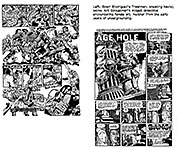
In 1968, Bill Griffith got his start in undergrounding (my interview with him in Cartoonist PROfiles No.101, March 1994 appears in Harv=s Hindsight for June 21, 2011). Griffith grew up in Levittown, New York, the post-World War II housing development that gave housing developments a bad name. All the houses looked exactly alikeCa monotonoous, sterile enrivonment.
AMad was a life raft in a place like Levittown, where all around you were the things that Mad was skewering and making fun of,@ Griffith told me in our interview.
But Griffith first pursued the artist=s muse, not the cartoonist=s. After graduating from high school in 1962, he went to Pratt Institute in Brooklyn and studied painting and graphic arts, leaving between his sophomore and junior years to spend a year in Pris, where he lived in a garret (Athe top floor of a cheap hotelCI even had a skylight@). When he returned to Brooklyn in 1965, he freelanced at whatever art jobs he could find.
He moved to the Lower East Side of Manhattan in about 1967. There he saw his first underground comics in the EVO.
AI had repressed the comedian and the cartoonist in me for too long,@ Griffith recalled. ASeeing the comics in the EVO burst the bubble. I just did a comic strip one day [late in the pivotal year 1968] and took it down to Screw.@
Screw was a freshly founded weekly pornographic tabloid newspaper offering AJerk-Off Entertainment for Men,@ as it proclaimed on its cover. Founded by Al Goldstein and Jim Buckley, it was first published in November 1968.
Griffith continued: AThe times being what they were, completely free-wheeling, it was relatively easy to get published. My message seemed to be sufficiently anti-establishment, anarchicCand, most important, as I found out, the right size. I took it in to Steve Heller (who became the art director at the New York Times), and he pulled out a ruler and measured it. >Hey,= he said, >Cit=s the right proportions. We=ll use it"=
AI was one of the few contributing cartoonists who had bothered to measure what a half-page tabloid size was,@ Griffith continued, ACand I=d drawn it the right size. I don=t think they even read my first five or ten strips. They were just so thrilled that they were drawn to the correct proportions.@
I chimed in: ASo now all aspiring cartoonists reading this will seize upon the right proportions as the direct route toC@
ACto fame and fortune,@ Griffith finished with a laugh. AJust measure correctly. The ruler is the pathway to stardom.@
MEANWHILE, IN SAN FRANCISCO, Zap Comix was expanding. With No.2, it included contributions from two poster artists, Victor Moscoso and Rick Griffin, and a particularly derisive cartoonist, S. Clay Wilson.
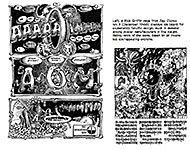 |
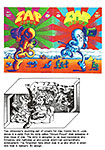 |
A couple of the earliest Zap stories are satirical in an almost traditional wayC "City of the Future," which ridicules blissful futuristic visions; and "Whiteman," which lays bare the repressed middle-class male. But stories like "Meatball" (about an inexplicable rain of meatballs, hits of acid, that transform everyone struck by one) and "Hamburger Hi Jinx" (in Zap No.2), play with subjects in ways that are most amusing, probably, to tripping readers.
The early stories were fun-loving rather than fierce satire; that changed with the debut of Wilson.
A heavy drinker (wine and beer), Wilson had drifted into the Haight one day from Nebraska. An art school graduate, Wilson saw himself as an art outlaw whose function was to use his art to puncture the "booshwah" balloon, to strip "the mass delusion" from the eyes of the American middle class.
"A seething, visionary kinda guy,@ Crumb said.
Wilson's contribution to
the second issue of Zap Comix was violently different from the good-natured
big-foot material. Wilson drew stories about bikers and pirates and
lesbians and all kinds of unsavory demonic freaks. And he drew them as
grotesque gargoyles, ugly and malformed and repulsiveC covered with blemishes and scars,
warts and unruly hair. His graphic style was raw and uncompromising, and
his characters were relentlessly brutish, violent savages who stabbed and
chewed each other to bits whenever they weren't committing bizarre sex acts. 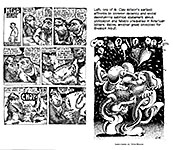 Wilson held
nothing back, made no concession to social convention whatsoever; he relished
offending every civilized sensibility.
Wilson held
nothing back, made no concession to social convention whatsoever; he relished
offending every civilized sensibility.
Crumb=s pacesetting performance aside, he was not responsible for the first underground comic book. That distinction belongs to Frank Stack (with an able assist from Gilbert Shelton). While an art student at the University of Texas, Stack was editor of the campus humor magazine, the Texas Ranger, in 1958-59, and he met Shelton and published his cartoons. The two aspiring cartoonists became friends, and Shelton eventually became editor of the magazine. While editor, Shelton published in the December 1961 issue of the magazine an installment of his Wonder Wart-HogC "the Hog of Steel"C a screamingly funny send-up of Superman and the traditions of the long underwear legions.
According to Stack, Shelton had been producing stories about the "Big Pig" since high school. And he recruited everybody he knew to help him write the stories:
"I spent hours with him, talking about drawing and jokes in Wonder Wart-Hog as did Lynn Ashby and Bill Helmer in the fall of 1961C probably others did, too, including nonsense poet Lieuen Atkins with whom Shelton collaborated often. He gave credit to Bill Killeen, but I'd say he was just being generous. He was the sole owner and proprietor of Wonder Wart-Hog, script and character and concept. He was, perhaps, despite what some people said of him, very modest about his talent and generous in acknowledging help he got from his friends."26*
(Footnotes marked with an asterisk, as this one is, are lengthy and offer more information as well as simply citing a source. They should, probably, be included in the text, but I didn=t want to interrupt the flow of this deathless prose, so I footnoted. Now let me resumeC:)
(Killeen, incidentally, later went to Gainesville, Florida, where he started an off-campus humor magazine, Charlatan, to which Shelton contributed more of the Hog of Steel.)
In the spring of 1962, Shelton made one of his periodic trips to New York to storm the bastions of professional cartooning. He was mostly unsuccessful, but he spent some time there with Stack, who was then finishing a stint in the Army. They both went back to Austin that summer, Stack en route to graduate study in art at the University of Wyoming in Laramie in the fall.
About that time, Shelton, who was perpetually launching one underground project after another, started a renegade broadside, The Austin Iconoclastic Newsletter (which was called "The" for short), and from Wyoming, Stack occasionally supplied him with some cartoons and single-page comic strips about Jesus Christ in which the Savior is viewed, somewhat (noC entirely) irreverently, from the twentieth century perspective of a person who has read the New Testament with an appreciation for the human predicament rather than an appetite for the divine message.
(When Jesus stops a group of men who are stoning a woman and admonishes them, saying, "He who is without sin should cast the first stone," one of the stoning party, grasping the situation instantly, hands a stone to Jesus and says: "Gosh" Sorry we started without you, Jesus. We didn't know you went in for stuff like this. HereC bop her a good one.")
Raised in the Methodist persuasion, Stack was a regular church-goer until he went to college, whereupon he lapsed and never came back. AThe basic idea of [the Jesus cartoons],@ Stack writes, Acame from a chapter in The Brothers Karamazov called >Dimitri=s Dream= or >The Grand Inquisitor= in which Christ returns [to earth], only to be arrested and imprisoned.@
Shelton, vastly amused by Stack=s sacrilegious productions, decided to disseminate a collection of them. He took eight of Stack's single-page strips to a friend who had access to a photocopying machine and together they ran off about fifty copies of each page. Shelton supplied the cover, a thumbnail-size drawing of the head of Jesus, with the title, The Adventures of J, and the byline, "By F.S.," and stapled all the pieces together, creating the first booklet of comix.
Jack Jackson (Jaxon) had just arrived in Austin with an accounting degree and was working in the state capitol and hanging out with Shelton and others who produced the Texas Ranger. "It was rather like a little oasis for us, this wonderful little thing called The Adventures of J," he said. "For somebody like me, who had all these religious hangups that I still hadn't shaken, this was just a breath of fresh air. It poked fun at the Scriptures and the sanctity and Godhead of Jesus and all that, and rather made him like a normal guy. Frank Stack, bless his heart, is finally getting some belated recognition on that."27
Two years later, Jaxon published his own "breath of fresh air"C God Nose (whose history is explained in Part One of this essay; in Harv=s Hindsight for August 15). And shortly after that, all the Texas alums were in San Francisco.
BY 1966 OR SO, THE CAMPUS HUMOR MAGAZINE scene "fell apart," according to Jaxon ("People did things that alienated the school censors"). Shelton and Jaxon had heard about the poster business in the Haight; Chet Helms of the Family Dog was an expatriate Texan ("one of the old peyote party"), and Jaxon went to San Francisco to make posters for Helms. Shelton made the trip in 1968C also intending to cash in on the poster tradeC and about the same time, so did two other Texans, Dave Moriarty and Fred Todd. The four of them pooled their resources and bought an old Davidson printing press, moved it into Don Donahue's loft upstairs at Mowrey's Opera House, and began providing an alternative to the Print Mint for both comix publishing and poster production.
In January 1969, they started calling themselves Rip Off Press, and their first publication under that name was a collection of Stack's cartoons and strips about Jesus. Called The New Adventures of Jesus, this was in regular magazine format, and it identified "F.S." as "Foolbert Sturgeon." The name, Stack told me, although inspired by the initials, was intended to sound like Gilbert Shelton, "deliberately to confuse."28*
By this time, Shelton had gone beyond college humor as a cartoonist. In 1967 while still in Texas, he had created a 16mm movie called "Texas Hippies March on the Capital." To promote the film, he drew a comic strip about three potheads desperate to score some grass. The trioC Phineas, Freewheelin' Franklin, and Fat FreddieC were better received than the movie, so Shelton gave up his film career and began cartooning the Fabulous Furry Freak Brothers. Shelton's strips appeared in the L.A. Free-Press and in various underground outlets, but their splashiest debut was in Shelton's first comix book, Feds `n' Heads, published in 1968.
Harvey Kurtzman reportedly thought Shelton the most professional of the underground cartoonists.29 And certainly if professionalism means consistent quality and long-range commercial reliability, Shelton qualified.
In the Freak Brothers, he created idiotic icons for the youth drug culture: sex-starved and dope-hungry, they are perpetually seeking a girl or a stash and are almost always frustrated, ludicrously, in the attempt. Shelton's work fits the classic mold for comic strip comedy. And he deployed the medium with a sure hand; his stories always conclude with a comic punch. Comix by Shelton do not leave the reader befuddled by philosophical conundrums or enraged by social injustice: they make the reader laugh. (Well, sometimes a bit of philosophy creeps inC like Freewheelin' Franklin's immortal axiom, uttered in the very first post-promotional appearance of the trio: "Dope will carry you through times of no money better than money will carry you through times of no dope.")
Rip Off Press published the first collection of Freak Brothers strips in 1971. Since then, dozens of Freak Brothers books have appeared. By 1984, over two million comix, books, and posters about them had been sold worldwide, and their adventures have been published extensively in foreign translations.30 Their popularity easily outlasted the counterculture that spawned them.
The secret of their appeal to the youth of subsequent decades is doubtless a certain timelessness: as potheads perpetually in pursuit of an illegal substance, they are in active rebellion against the rules of their society just as most young people are in rebellion against the custom of their elders.
Says Shelton (with a perfect awareness of exactly what he is doing): "They're traditional literary characters just doing the same things that people have always done in more-or-less contemporary garb."
The Haight, the East Village and Austin were not the only venues for comix in those formative years. In Chicago, Jay Lynch, another thorough-going professional humorist and cartoonist, was also nurturing the infant medium. Like virtually all underground cartoonists except Crumb, he spent his fledgling years on college humor magazines. While studying at the Art Institute of Chicago, Lynch contributed to Aardvark ("The Kicked-Off Campus Humor Magazine" for Roosevelt University). He also sent cartoons to Killeen's Charlatan in Florida. Between 1962 and 1966 (while a student in college), he wrote for Cracked and Sick, the Mad imitations.
He was in touch with almost all of the cartoonists whose work would shape comix. Through a letter he read in Cracked in 1961 when he was about 16, he met (by exchange of letters) Art Spiegelman in New York and the late Skip Williamson, growing up in Canton, Missouri. And when he visited Killeen in 1963, he saw Shelton's Wonder Wart-Hog and was soon corresponding with Shelton and Jaxon. Lynch would make trips to New York to hang out with Spiegelman, who later started a humor magazine at Harpur College called Mother. He journeyed to Missouri to see Williamson.
Visiting and corresponding with many of the ug cartoonists, telling everyone what everyone else was doing, Lynch was a veritable linchpin of underground comix.
In 1967, Williamson moved to Chicago with the object of joining Lynch in producing a humor magazine. They launched the Chicago Mirror, "a kind of magazine somewhere between the Realist and Mad," Williamson said.31 Lynch elaborated: "It was a satire magazine for hippiesC which was a contradiction in terms since the hippies en masse seemed, by this time, to totally lack a sense of humor. By 1967, hippiedom had become a national fad and converts to it were predictably humorless."32
Lynch saw a copy of Zap Comix No.1 and changed direction. He and Williamson preferred cartooning to the comic journalism of the Chicago Mirror, so they abandoned their first-born and conceived Bijou Funnies, destined to become one of the longest-running early anthology titles in the underground. For it, Lynch produced stories about Nard and Pat, an Andy Gumpish bachelor and his ne'er-do-well pet cat (whom Lynch had invented earlier while contributing to the Chicago Seed), drawing in a meticulously clean and uncluttered manner and modulating the stark black and white pictures with a range of grays in zipatone.
Williamson's graphic style
is similarly unencumbered, but his work has an entirely different
appearance: affecting an Art Deco flatness and adding texture with a
variety of crosshatching and patterning, Williamson created Snappy Sammy Smoot,
a counterculture Candide who, despite repeated defeats, never loses his
innocence. 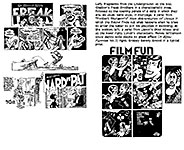 (For biographical and ug histories of Lynch and Williamson, see Opus
364 for their obits.)
(For biographical and ug histories of Lynch and Williamson, see Opus
364 for their obits.)
Crumb came to Chicago to observe the "yippies" at the Democratic National Convention that summer, and he stayed with Lynch. While there, he drew the comics that he contributed to the first issue of Bijou, which was published shortly after the Chicago Convention debacle.
Meanwhile, in Wisconsin, another humor magazine was about to give birth to a comix magazine. In Milwaukee, Denis Kitchen was fermenting his own homebrew of comix in the fall of 1968. He'd been co-founder, art editor and the chief cartoonist for the first issue of Snide, a humor magazine for the University of Wisconsin. And when the other founder scarpered with the first issue's profits, Kitchen was left with a pile of cartoons he'd prepared for the second issue. Not wanting to have his effort come to naught, he decided to do some more comics and publish the lot in his own magazine.
One problem, a problem typical for the time. He=d graduated from UW in June, and he was almost immediately drafted: in November, he was to be inducted into the army, an event that he, like millions of others in those days, wanted to avoid. He knew he=d probably be sent to Vietnam, a war he opposed, so he sought ways to escape this fate, as reported in Kitchen Sink Press: The First 25 Years.
Tall and thin, he desperately tried to lose enough weight to disqualify him for service. But come November, one pound over the minimum weight for his six-foot-five frame, he was shipped to Fort Campbell, Kentucky, where he quickly entered a conspiracy with another borderline weight case, an overweight inductee equally desperate to adjust his weightCbut to gain pounds, not lose them.
AHe ate my mashed potatoes,@ Kitchen reported, Aand I ate his crackers and water. Twenty-two days later we both got out.@
Back in Milwaukee by
December, a bohemian denizen of the post-graduate enclave on the fringes of the
college campus, Kitchen frequented the local head shops and counterculture
boutiques and saw copies of Zap Comix and Bijou Funnies in the
stores. Inspired by what he saw, he completed his project, publishing Mom's
Homemade Comics No.1 ("Straight from the Kitchen
to You") in the spring of
1969. 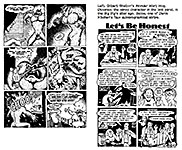
A roommate took copies to San Francisco for sale through Gary Arlington's shop, the San Francisco Comic Book Company on 23rd Street in the Mission District, and made arrangements with the Print Mint for reprinting the first issue (which had successfully sold out) and for printing the forthcoming second issue. But with the second issue, a dispute over revenue ensued, and Kitchen decided he would be happier publishing his own comix, so he severed relations with the Print Mint and began preparing material for the third issue of Mom=s.
Kitchen sent copies of his comix to Crumb and Lynch and other worthies. Crumb wrote to encourage him. And later in 1969, when Crumb was visiting Lynch again, he and Lynch took a trip to Milwaukee to meet Kitchen. Lynch=s Bijou Funnies was being published by the Print Mint, and when Lynch found out later that Kitchen was jumping the Print Mint ship to publish himself, he asked Kitchen if he would publish Bijou Funnies, too.
"Sure," Kitchen said, "C two's as easy as one." A fateful comment. And naive, as Kitchen was soon to discover (and always to admit).33 But it was the cornerstone of a publishing empire: Kitchen Sink Press prospered and established new standards of quality in product and of equity in the treatment and payment of cartoonists.
DESPITE ALL THE INNOVATIVE ENTERPRISE in the Austin and in the country's heartland, San Francisco was still the hub of the comix movement. Bill Griffith (whose underground character, Zippy, was eventuallyCastonishinglyC syndicated by King Features in 1986), started in the Village but moved to San Francisco immediately after his first visit there in April 1970. He had been contributing strips about Mr. Toad to the EVO and Screw, both published in the East Village, but San Francisco was "a magnet," he said; "there was no resisting its pull."
For an underground cartoonist, it was, by then, about the only place to be. The underground newspaper comic strip in New York had expired by the end of 1970; comic books were the only outlet, and they were published most regularly in San Francisco.
"Within a very short time, almost all the cartoonists had either come out to San Francisco," Griffith told me, "or had stopped doing comics. Everybody came out. I was just part of a wave of people coming out here."34
For most cartoonists, cartooning is essentially a solitary occupation, but the ambiance of San Francisco at that time was more like that of the fabled Mermaid Tavern of Elizabethan England where people got together frequently and talked about what they were doing.
"It was like an art movement," Griffith said. "You joined an art movement; that was the feeling. It was a lot of things. First of all, it was a definite part of the hippie movement, the counterculture. We were part of the whole Haight-Ashbury scene. By 1970, it had started to fadeC or change, at least, the tail end of the countercultureC but it was still very much alive in the social sense of everybody feeling connected. There was a kind of party atmosphere to some degree; and then there was the sort of salon atmosphere. We hung around Arlington=s comic book store. If we were a salon, he was Gertrude Stein. In fact, he kind of looks like Gertrude; he looks more like Gertrude Stein every year.
"We would hang out at the comic book store," Griffith continued, "and we would have regular parties at the publishers' offices, Rip Off Press and Last Gasp."
The last of the major
underground presses, Last Gasp Eco Funnies was founded in late 1969 by Ron
Turner to fight for the preservation of the ecology; its first title, Slow
Death 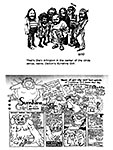 Funnies, was published in 1970. The salon atmosphere often
crackled with discussions of the causes taken up by the counterculture's
crusading spirit.
Funnies, was published in 1970. The salon atmosphere often
crackled with discussions of the causes taken up by the counterculture's
crusading spirit.
"There were plenty of factions within underground comix," Griffith said, "just as there were within the prevailing counterculture, so some cartoonists felt a responsibility to promote certain ideas."
AMONG THE FACTIONS was a small group of women cartoonists. Trina Robbins and Kim Deitch left New York and Robbins= dress-making business in late 1969, joining the lemming-like migration of ug cartoonists to San Francisco. And it wasn=t long before Trina began to feel resentful of her treatment as a woman cartoonist. When encountering new bunches of cartoonists, she was introduced as a dress-makerCif she was introduced at all.
In her autobiography Last Girl Standing, Robbins reports missing out on cartooning assignments because the Ainner circle@ of misogynist male ug cartooners ignored her being a cartoonist, as they ignored all women cartoonists.
Disregarded because she was female, she become a feminist. Out of justifiable resentmentCTrina=s and others=C the women=s movement in comics was doubtless born.
In her essay in Underground Classics, Robbins makes the case that women cartoonists produced comix in protest against male preoccupation with abusive sex. With Barbara AWilly@ Mendes, Trina co-edited the first all-women comic book, It Ain=t Me, Babe, in 1970, and was deeply involved in Wimmens Comix, the first all-woman underground comix, the product of a Awomen=s collective.@ (Trina edited only one; for the first issue, she produced the first-ever story about an Aout@ lesbian, ASandy Comes Out@).
She traces the growth of comix by women and notes that comix were in part reacting against the repressive Comics Code Authority that had destroyed imaginative works in mainstream comics and in part embracing the hippie dogma to Alet it all hang out.@
Ugs offered females first
opportunity to enter the medium. Said Trina: AWe tackled subjects that the guys
wouldn=t touch with a ten-foot
poleCsubjects like abortion,
lesbianism, menstruation, and childhood sexual abuse.@ 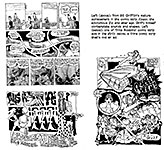
In the midst of this cultural ferment, Crumb felt no more a part of his society than he ever had. "I was taking LSD along with a lot of other people," he said, "and had the same values that a lot of people were expressing, but I wasn't really a hippie. I didn't get out there and play my bamboo flute and dance in my bare feet in Golden Gate Park with the rest of the hippies. I just wanted to sit in my room and jump on big women if there happened to be any around."35
But Crumb was scarcely staying in his room.
He was running all around the country, visiting other underground cartoonists and conferring with promoters and lawyers who wanted to help him cash in on his fame. He took very few of their offers, but he always used the airplane tickets they provided. He was in Chicago, Milwaukee, Detroit; he made the collegiate hippie scene in such places as Madison and Ann Arbor. And everywhere he wentC girls and sex.
"I got the clap; I got crabs," he said. "Lucky for our generation there was no Aids yet."36
Regardless of where he was, he drew comix. Most of Big Ass Comics No.1 was drawn in Los Angeles; most of Motor City Comics No.1, in Detroit. It was his most productive period.
Crumb credited his creative success during this period to taking acid: "It enabled me to separate my ego from the drawing a little bit, which allowed this whole flood of inspiration. If you have a heavy ego involvement which makes you worry about what you're doing all the time, it stiffens you up and causes a loss of spontaneity. Taking all that acid made my work very spontaneous."
Years of drawing had given him the technical facility; LSD freed him to exercise it. He couldn't draw while high, though; his inspiration came then, and he drew about it afterwards.
In the mid-seventies, beset by a variety of legal and financial problems, Crumb suddenly gave up using dope.
"I thought I would never have another source of inspiration," he said. "But as you get older, just the accumulation of your life becomes an inspiration. it's so rich and interesting in itself that you don't need anything else as inspiration except that."37
Although Crumb smoked grass and dropped acid for several years, he never bought any of the drugs. "There was so much around that people were giving it away," he told Gary Groth in The Comics Journal interview (No.121, April 1988). Besides, he couldn't afford dope.
Despite his fame, he said, he and Dana were living on her welfare checks until late 1971.38* She had worked in a home for unwed mothers until she became pregnant; after their son, Jesse, was born, she no longer worked. Living in the Haight was cheap then: they rented a two-bedroom apartment for $70 a month.
His dubious financial situation aside, Crumb was a celebrity and was being courted mercilessly by all sorts of hustlers and hangers-on, journalists and promoters, sharpies and high-powered operators, and every other kind of wheeler-dealer imaginable.
"It was like being gang-banged your first day in prison," he once wrote.
Too young and inexperienced (and too stoned some of the time) to understand what was happening, Crumb was sometimes trapped into schemes he really wanted no part of. For the most part, howeverC miraculously it seemsC he resisted their aggressive blandishments. He was able to do so chiefly because he was, in his phrase, "a committed bohemian." He was wary of the "big time." He believed he'd be better off without it, and he was determined not to sell out.39
But animator Ralph Bakshi and producer Steve Krantz found a way around Crumb's defenses.
The men's magazine Cavalier had printed a series of Crumb's Fritz the Cat stories from February to October 1968; and that summer, Viking had brought out a book of Crumb's comix, including stories of the fated cat. Of Crumb's characters, Fritz the Cat was probably the best-known outside the counterculture. Bakshi was animating Saturday morning cartoons for children and saw Fritz as a portal to fame and fortune. He was apparently so eager about the prospect that he began doing the animation for a Fritz the Cat film before consulting Crumb. Finally, some of the film having been completed in pencil animation, Bakshi and Krantz approached Crumb.
Crumb wanted no part of it but, reluctant to slam the door in their faces, told them he'd think about it, and they went away to continue to work on the film. And when Bakshi and Krantz discovered that Dana had Crumb's power of attorney, they convinced her to sign, giving them permission to make movies starring the cat. They gave her a check for $10,000, and she immediately bought property in Potter Valley a few miles north of San Francisco.40* Crumb was eventually paid another $38,000-39,000 for the film; the checks came along every so often over the years.
"Fritz the Cat" came out in April 1972. Crumb hated it. He disowned the character. Then, seeking to destroy the movie moguls' options, he drew "Fritz the Cat, Superstar" later that year (published in People's Comics). At the end of the story, the callous and unfeeling lover Fritz is killed by a girlfriend who plunges an ice-pick into his head. But Krantz and Bakshi (whose career was suddenly on the rise because of the film) were not deterred: owning all movie rights to Fritz the Cat, Krantz made a second film, giving it the ironic title, "Nine Lives of Fritz the Cat."41
And Crumb had other troubles.
After losing a legal fight
to retain the rights to his "Keep on Truckin'" slogan and drawings in 1976, he found
he owed the Internal Revenue Service $20,000, ostensibly on income he derived
from law suits brought against those who used this creation without permission.
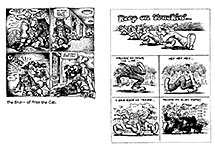 Apparently, his lawyers didn't set aside any of the money for withholding tax
after raking off their share. And neither did the fiscally carefree
Crumb.
Apparently, his lawyers didn't set aside any of the money for withholding tax
after raking off their share. And neither did the fiscally carefree
Crumb.
The windfall of cash from the Bakshi film was still years in the future (he received the last check, for $31,000, in 1982). Crumb began paying off the debt in installments, but the penalties continued to mount on the unpaid balance. The nightmare didn't end until 1978. Long before then, Crumb had had enough.
Overwhelmed by the fame and its attendant complexities, Crumb fled to Potter Valley and holed up in a little shack on the property. It was a cozy warren, crammed floor to ceiling with old records, magazines, toy cars and robots and airplanes and other detritus of his forays to flea markets. Thomas Maremaa writing in the New York Times Magazine described Crumb's working style: "He works more or less when he feels like itC often at nightC drawing new strips spontaneously in either pencil or ink. His habits are almost spartanC he neither smokes nor drinksC and he abhors television, calling it an >energy rip-off' and >bad medicine.'"42
Crumb and Dana were effectively separated even while living in Potter Valley: she lived in the main house with her new boyfriend; Crumb lived in his little cabin, visited by a stream of admirers both male and female ("hippie floozies," Crumb called the latter). For a time, he was surrounded by small assemblies of fans, who gathered in his cabin to smoke pot and listen to records and talk. In this convivial setting, Crumb couldn't work.
And he wouldn't tell them to leave: he had for so much of his youth been excluded from such groups, and now that he was accepted, lionized, he was loathe to deny himself the pleasure of the experience.
He talked with them all during the day and evening, passing the joints around, and then after they'd gone late at night, he'd turn to his drawingboard and resume work on the comix pages in front of him.43
As the seventies came to a close, the hippie fad passed away. Underground comix seemed to disappear (they hadn't; they just seemed to), and Crumb was able to work undisturbed.
He continued to produce comix regularly throughout the seventies and eighties and longer. Although he never was again as prolific as he'd been in the first flush of the comix phenomenon when he produced over 150 pages a year in 1969 and 1970, he generated 50-80 pages annually for most of the period.44*
His style became more ornate as he studied and employed the profuse cross-hatching techniques of old-time cartoonists like Thomas Nast to give his pictures texture and depth. And in the selection and treatment of subjects, he grew more serious not to say dour. Some of his stories read like strident sermons; and his satire is often pitilessly grim. The playful one-pagers of the early giddy issues of Zap and Snatch were not reprised.
The Crumb character, his autobiographical caricature, was still the most constant presence in his work. Although the two installments of "My Troubles with Women" might appear in their unvarnished candor to have exhausted him at last on the subject, Crumb disagreed.
"That can go on forever," he told Groth. "The first time I did that, by the time I finished, I realized that I had barely scratched the surface. And when I finished Part Two, I realized I was still just beginning to deal with it. That's a subject where the more I think about it the more I realize. I could go on to Part Twenty-five of that."45
Crumb has appeared as a character in his own work since the first issue of Zap. And autobiographical creation held a special fascination for him. The earliest manifestations of the Crumb caricature were self-deprecating comic turns, but Crumb began to see the character as a way of getting to the truth and thereby of achieving authenticity.
"To tell the truth about your own experience and do it in a way that's funny and entertaining is really a gift," he said. "I'm real attracted to that whole self-deprecation thing where you make yourself an absurd character."
He's put off by cartoonists who make themselves cool and heroic in autobiographical works.
"It's like neutralizing yourself," he said. "Everything around you is nuts, but you're cool? Dishonest. They aren't being honest with themselves. It's hard to admit that you're not perfect, especially publicly."
When he began editing his own magazine, Weirdo, in 1981, he looked for material that had some subconscious truth in it.
"That's the only way I can explain my editorial policy: gotta be something like personal truth in this stuff."46
Crumb divorced Dana in March 1977, and in January the next year, he married Aline Kominsky, with whom he had been living for several years. In the early nineties, he moved to France, seeking refuge from the shysterism of the American system that he so despised (not to mention a better tax situation).
His work has been extensively reprinted ever since the second printing of Zap Comix No.1, and his income from these projects was ample to support him in the modest fashion he enjoyed. And he continued to produce powerful albeit more deliberate comics (some for The New Yorker, whose art director, Francoise Mouly, is married to Art Spiegelman)C as always, with the complete artistic freedom that he exercised when he first catapulted himself into the public eye, a freedom he had been at great pains to preserve ever since fame first washed over him.
In his 1987 interview with The Comics Journal=s Gary Groth, Crumb explained his motivesC perhaps every artist's motivesC displaying once again the kind of insight and passion that has distinguished his career: "One of my main reasons to go on living is I still think I haven't done my best work. I get scared and think I'm running out of time. I've still got a body of work to do. I can't leave it at this, you knowC it's not good enough. I'm just getting there."47
AFTER A FEW DELIRIOUS YEARS of unencumbered comix production in the various hotbeds of protest and revolutionary ridicule, underground comix were suddenly snuffed out. The change that ended ugs was the Supreme Court decision in 1973 that declared that local standards could determine obscenity. The chief distribution means of ugs, head shops, couldn=t risk it anymore: their connection with drugs already made them a threatened species. Without distribution, comix slowly died.
By choosing rebellion and confrontation with the power structure of conventional life, ugs sowed the seeds of their own destruction. Said Kurtzman: AThe underground was doomed to self-destruction. Like the Shakers who didn=t believe in sex, the underground didn=t believe in survival. As Shelton put it: >If we succeed, we=ve failed. But if we fail, we=re successful.=
AThe underground cartoonists had a suicidal philosophy,@ he continued, Aand the ones I knew were all very frustrated guys, torn between a desire for material success and a contempt for it.@
But comix had a profound and lasting impact upon the mainstream comic book industry. Very early, comix publishers responded to cartoonists= need to own their own material. And soon, the mainstream publishersCDark Horse and Marvel and DC and othersCresponded. First, by returning the artwork to the artists; second, by sharing profits. These adjustments invariably led to better product: more accomplished writers and artists were attracted to comics and produced work in them.
And comix affected the form itself, too. The autobiographical nature of many of the comix stories led, at least indirectly, to the emergence of the graphic novel. But the graphic novel was also the beneficiary of other aspects of the post-comix world. The improving quality of comics led to increased circulation and sales, which permitted and encouraged longer worksCgraphic novels.
Would graphic novels have come about without ug comix? ProbablyCunder the influence of European comics, which, with the gradual ascent of comics up the social approval scale, began to have an effect on comic book artists and publishers in this country. But the wild excesses of comix doubtless hastened the development.
Sources. Much the foregoing (the footnoted parts) is taken nearly verbatim from the ninth chapter of one of my books, The Art of the Comic Book, about which you can read more by clicking here. In the book, I examine Crumb=s work in some detail; you can get a hint of that by clicking here, which will take you to another entry in the Hindsight department, one devoted entirely to CrumbCAThe Lonely Hearts Club Band,@ July 7, 2007. This installment of my history of underground comix carries footnotes from its initial publication in my book; we resume the footnoting with No.22.
For full titles of the sources, refer to Part One of this essay, where the footnoting and numbering began.
22 Thomas Albright, "Zap, Snatch and Crumb," Rolling Stone, 28 (March 1, 1969), p. 25; quoted by Donald M. Fiene, R. Crumb Checklist of Work and Criticism (Cambridge: Boatner Norton Press, 1981), p. 153; and Claude Chadwick (pseud. of Marty Pahls), "Robert Crumb: King of the Underground Comics," National Insider, 14/4 (January 26, 1969), p. 13; quoted by Fiene, p. 153.
23 R. Fiore, "Funnybook Roulette," The Comics Journal, 121 (April 1981), pp. 45-46.
24 Estren, p. 236-37.
25 "The Dating of Zap Comix," p. 4.
26 Frank Stack's letter to me, dated January 15, 1995. "Something else about Gilbert," Stack goes on: "he was an active participant in the Austin music scene, jammed on the banjo at Threadgills, wrote country blues songs, and recorded the memorable `Set Your Chickens Free"' He was also an amateur athlete and semi-professional stock car racer. Modest on one level, supremely cocky and confident-seeming to others--he was extraordinarily good looking and charismatic. Several beautiful women in Austin and San Francisco were in love with him. He was an amusing and attractive guy--genuinely brilliant, too--still is, though ravages show in his countenance now (well, wouldn't they, twenty-five years later?)."
27 Wiater and Bissette, p.
33.
28 Stack's letter to me. Initially, Stack told me the story of the origins of The Adventures of J in a telephone conversation on January 3, 1995. The little eight-page (plus cover) opus was produced, he thought, either in the late summer or fall of 1962, probably after the collapse of Shelton's newsletter (but maybe not). He also told me that he wanted Shelton to call Wonder Wart-Hog "the Pig of Iron," but Shelton didn't go for it. Stack remembered that it was Bill Helmer, then an editor with True West magazine, who photocopied the first issue of the little booklet. But when I talked to Helmer a week or so later, he said he wasn't in Austin at the time. A former editor of the Texas Ranger (he followed Stack), Helmer was in New York while Stack was there and returned to Austin in 1963. He lived near Shelton, and Shelton gave him some copies of The Adventures of J, which, Helmer believes, had been sitting around in a desk drawer somewhere, uncirculated; the pages Helmer received weren't even stapled together. Helmer took them to his office and ran off a few copies, earning a look of askance from his boss, Joe Small, who was a fairly religious fellow.
If Helmer=s recollection is accurate, The Adventures of J arrived in 1963, not 1962. But even at that later date, it qualifies as the first underground comix.
Geerdes quite rightly points out that these early productions have been termed underground comix in retrospect: "The concept [of underground comix] was unknown in 1962; it became popularized in the mid-1960s through the proliferation of underground newspapers" (p. 3).
29 Estren, p. 59.
30 "Rip Off Press: The Publishing Company That's a Little like the Weather," interview with Gilbert Shelton, Fred Todd, and Don Baumgart, The Comics Journal, 92 (August 1984), p. 69.
31 "The Strange World of Snappy Sammy Smoot: An Interview with Skip Williamson" by Grass Green, The Comics Journal, 104 (January 1986), p. 52.
32 "Destroying Idols: The Role of Satire and the Free Press in Comics," an interview with Jay Lynch by Grass Green, Craig Yoe, and Jackie Lait, The Comics Journal 114 (February 1987), p. 86.
33 Dave Schreiner, Kitchen Sink Press: The First 25 Years (Northampton, Massachusetts: Kitchen Sink Press, 1994), pp. 8-15.
34 R. C. Harvey, "Zippy and Griffy," an interview with Griffith, Cartoonist PROfiles, 101 (March 1994), p. 37. The entire article is reprinted in Harv=s Hindsight for June 21, 2011.
35 "Straight Dope," p. 88.
36 Robert Crumb, "Introduction," The Complete Crumb Comics, Vol. 6 (Seattle: Fantagraphics Books, 1991), p. viii.
37 "Straight Dope," p. 120.
38 Crumb's memory is probably a little hazy. Dana was undoubtedly collecting welfare checks, but that could scarcely have been their only income. Crumb had sold cartoons to Cavalier magazine throughout 1968, and he had been advanced $2,500 by Viking for a book of Fritz the Cat (which was eventually published by Ballantine in 1969). Viking presumably paid him for R. Crumb's Head Comix, which came out in the summer of 1968. Also in 1968, he designed a record album cover for Janis Joplin's Cheap Thrills. In 1969, Ballantine brought out its edition of Head Comix, for which he received an advance of $5,000; and he did a second album cover for Joplin. In addition, he contributed artwork to a dozen or more papers or magazines in 1969, and he did stories for over two dozen comix. The pay might not have been much, but as the underground's best-selling cartoonist, it could not have been entirely negligible. Crumb almost certainly didn't pay much attention to money, and he may not have carried much around with him; and Dana doubtless acquired a good bit of what he earned. But they were not poverty-stricken.
39 Crumb, "Introduction" to Vol. 5, pp. vii-viii; all of this and the preceding paragraph is based upon information on these pages.
40 Fiene says it was the Ballantine advance of $5,000 in 1969 that Dana invested in Potter Valley property. He pegs the Krantz advance at $7,000 in August 1970. The $10,000 payment cited here as well as the amounts of subsequent payments are supplied by Crumb during his interview with Gary Groth; and the cartoonist's ability to recall facts from the past on the spur of the occasion is probably no better than anyone's (which is to say, not fully reliable). The amounts of the supplemental payments were not very great according to Fiene; but the last payment, reportedly $31,000, wasn't received until after Fiene's book was published.
41 "Straight Dope," pp. 74-75 provide Crumb's account of the Fritz the Cat episode. Bakshi had split with Krantz by the time "Nine Lives" was produced; it was directed by Robert Taylor and was released in 1974 (Fiene, p. 92).
42 "Who Is This Crumb?" (October 1, 1972), p. 73.
43 Robert Crumb, "Introduction" to Volume 7, p. vii-viii, recounts this period in his life.
44 Donald Fiene, "Crumb Chronology" excerpted in The Comics Journal, 121 (April 1988), p. 123. To put Crumb's production in perspective, we can imagine that a full-time comic book cartoonist on a monthly comic book during the same period probably cranked out about 200 pages a year. John Byrne may have done as much as 280 pages a year (my estimate) on his Next Men series for Dark Horse. Alex Ross, doing full-color paintings for Marvels, says he did all 180 pages in a year, an extraordinary feat ("Overthinking Things," his afterward in Marvels, the trade paperback that reprinted the five issues of the magazine [New York: Marvel Comics, 1994], n. pag.). Jack Kirby, whose ability to create prodigious quantities of quality work is one of the wonders of the modern world, averaged 375 pages a year over his half-century career; in 1962, his most prolific year, he produced 1,158 pages of comic book art (Ray Wyman, Jr., The Art of Jack Kirby [Orange, California: Blue Rose Press, 1992], p. xxxiv).
45 "Straight Dope," p. 119-20.
46 Ibid., p. 110.
47 Ibid., p. 118.
